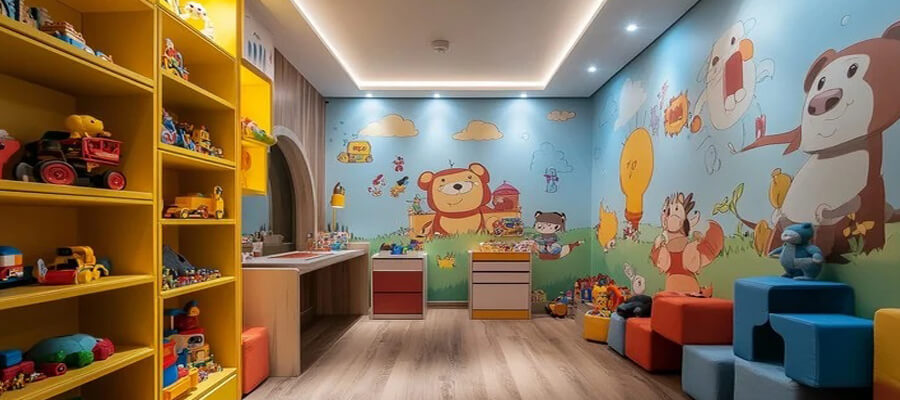
How to Set Up the Perfect Puppy Playroom
Create the Ultimate Puppy Playroom: A Guide for New Pet Parents
Introduction
Bringing home a new puppy is an exciting experience, and setting up a dedicated playroom is a fantastic way to give them a space where they can safely play, explore, and relax. A well-designed puppy playroom not only provides entertainment but also helps with training and socialization. In this guide, we’ll walk you through the essential steps to create the perfect puppy playroom that meets your pup’s needs and keeps them happy, healthy, and safe.
1. Choose the Right Space
Selecting the best location for your puppy playroom is key to making sure your pup feels comfortable and secure:
- Size and Layout: The space doesn’t need to be huge, but it should be big enough for your puppy to move around freely and have designated areas for play, rest, and potty training.
- Location: Pick a room or corner that’s easily accessible but not in a high-traffic area. Puppies need a balance of interaction and quiet time, so avoid noisy or overly busy spots.
- Puppy-Proof the Area: Remove any harmful objects, such as wires, small items, or toxic plants. Ensure that all doors, windows, and vents are secured to prevent accidental escapes.
2. Essential Items for a Puppy Playroom
Essentials for Your Newly Adopted Pet
Welcoming a shelter pet into your life is a beautiful journey. Here are some handpicked items to help your new friend feel safe, loved, and right at home:
Your puppy’s playroom should be equipped with everything they need to stay entertained, comfortable, and safe:
- Comfortable Bed: Provide a soft, cozy bed where your puppy can nap after playtime. Choose a durable, washable bed, as puppies may have accidents or chew on their bedding.
- Crate or Playpen: Incorporate a crate or a puppy playpen for safe confinement when unsupervised. Crates can also serve as a den-like space where your puppy can feel secure.
- Toys: Include a variety of toys to keep your puppy entertained, such as chew toys, soft plushies, and puzzle toys. Rotate them regularly to maintain interest and prevent boredom.
- Water and Food Bowls: Keep fresh water available at all times in spill-proof bowls. If you plan to feed your puppy in the playroom, have a designated feeding area with food bowls.
- Puppy Pads or Potty Area: If your puppy isn’t house-trained yet, set up a designated potty area with puppy pads or an indoor grass patch to help them learn.
3. Create Safe Zones
Your puppy playroom should be divided into different zones to make it functional and organized:
- Play Zone: This area should have interactive toys, balls, and other items your puppy can play with. Make sure the space is clear of any objects they might chew on that aren’t safe.
- Rest Zone: Designate a quiet corner with a soft bed or crate where your puppy can rest and relax after a busy play session.
- Training Zone: Keep a small area set aside for training sessions. This can include a space for potty training with puppy pads and a separate area for practicing commands or leash training.
- Feeding Zone: Keep food and water bowls in an easily accessible corner, far from the rest zone to avoid spills or accidents in their sleeping area.
4. Add Enrichment and Sensory Stimulation
Mental stimulation is just as important as physical exercise for your puppy’s development. Enrich the environment with sensory experiences:
- Interactive Toys: Puzzle toys or treat-dispensing toys can keep your puppy mentally engaged while they work to solve a challenge or retrieve treats.
- Textures: Provide a variety of textures underfoot, such as soft rugs, rubber mats, or a faux-grass patch, to engage your puppy’s sense of touch and encourage exploration.
- Climbing and Hideouts: Small ramps, tunnels, or boxes offer climbing and hiding spots to appeal to your puppy’s natural curiosity and help them burn off energy.
5. Safety Measures
Your puppy’s safety is the top priority in their playroom:
- Remove Hazards: Secure all cables, cords, and wires to prevent chewing accidents. Block off any gaps where your puppy could get stuck, and ensure there are no sharp edges on furniture.
- Non-Toxic Toys and Materials: Make sure all toys and materials in the playroom are non-toxic and safe for your puppy to chew on or interact with.
- Supervision Tools: If you need to leave your puppy alone in the playroom, consider using a baby monitor or pet camera to keep an eye on them and ensure they stay safe.
6. Regular Maintenance and Cleanliness
Keeping the playroom clean and hygienic is important for your puppy’s health:
- Daily Cleaning: Regularly clean up any messes, such as food spills, accidents, or shredded toys. Wash your puppy’s bed and toys frequently to avoid odors or bacteria buildup.
- Sanitize Potty Areas: If you’re using puppy pads or an indoor potty, make sure to clean and sanitize the area frequently to keep it odor-free and hygienic.
Conclusion
Setting up the perfect puppy playroom doesn’t have to be complicated, but it does require thoughtful planning to create a safe, comfortable, and engaging space for your new furry friend. By providing different zones for play, rest, and training, along with enriching toys and a cozy environment, your puppy will thrive and enjoy their own little corner of the world. A well-designed playroom not only keeps your puppy happy but also gives you peace of mind, knowing they have a secure space to grow and explore.
Keywords:
- Essential puppy playroom items
Affiliate Products
We may earn a small commission when you shop through our links — it helps us keep sharing love and care for every dog out there, at no extra cost to you.
Up to 75% Discount

Dog Collar with Health Monitoring
BUY NOW »
Up to 55% Discount

Luxury Faux Furhuge Napping Bed
BUY NOW »

